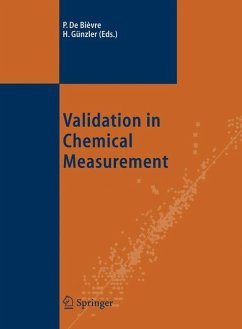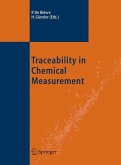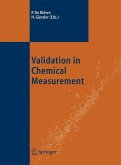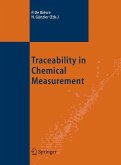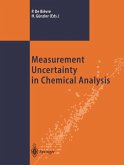The validation of analytical methods is based on the characterisation of a measurement procedure (selectivity, sensitivity, repeatability, reproducibility). This volume collects 31 outstanding papers on the topic, mostly published in the period 2000-2003 in the journal "Accreditation and Quality Assurance". They provide the latest understanding, and possibly the rationale why it is important to integrate the concept of validation into the standard procedures of every analytical laboratory. In addition, this anthology considers the benefits to both: the analytical laboratory and the user of the measurement results.
Validationofmeasurementmethodshasbeenusedforavery ciated measurement uncertainty? The answer must be: no. longtimeinchemistry. Itismostlybasedontheexamination Therecanneverbeamechanismorrecipeforproducing - of a measurement procedure for its characteristics such as tomatically valid results because one can never eliminate precision, accuracy, selectivity, sensitivity, repeatability, re- theskills,theroleandtheresponsibilityoftheanalyst. producibility,detectionlimit,quanti?cationlimitandmore. ISO 9000:2000, item 3. 8. 5 de?nes validation as con?r- When focussing on quality comparability and reliability mation by examination and provision of objective evidence in chemical measurement, the ?elds of interest to this Jour- that the requirements for an intended use are ful?lled . The nal, one stumbles into various interpretations of the term revised edition of the VIM ( VIM3 ), is likely to ?ne-tune validation. It is one more example of a term which is used thisde?nitionoftheconcept validation tobe con?rmation sometimes very consistently, sometimes very loosely or in- through examination of a given item and provision of - deed ambiguously. Since the term is very common in the jective evidence that it ful?lls the requirements for a stated chemical community, it is important that its meaning be intendeduse . nd clear. Turning to the 2 edition of the International Vo- Lookingatsimplepractice, manypeoplearelookingfor cabulary of Basic and General terms in Metrology (VIM) aformaldecisionthatagivenmeasurementmethod automat- (1993), surprisingly we do not ?nd a de?nition. Webster s ically gives them valid i. e. reliable results. One wonders Dictionary of the English language (1992) tells us that val- what this has to do with stated intended use . Reliab- idation is making or being made valid . Obviously valida- ity clearly is a property of a measurement result.
Validationofmeasurementmethodshasbeenusedforavery ciated measurement uncertainty? The answer must be: no. longtimeinchemistry. Itismostlybasedontheexamination Therecanneverbeamechanismorrecipeforproducing - of a measurement procedure for its characteristics such as tomatically valid results because one can never eliminate precision, accuracy, selectivity, sensitivity, repeatability, re- theskills,theroleandtheresponsibilityoftheanalyst. producibility,detectionlimit,quanti?cationlimitandmore. ISO 9000:2000, item 3. 8. 5 de?nes validation as con?r- When focussing on quality comparability and reliability mation by examination and provision of objective evidence in chemical measurement, the ?elds of interest to this Jour- that the requirements for an intended use are ful?lled . The nal, one stumbles into various interpretations of the term revised edition of the VIM ( VIM3 ), is likely to ?ne-tune validation. It is one more example of a term which is used thisde?nitionoftheconcept validation tobe con?rmation sometimes very consistently, sometimes very loosely or in- through examination of a given item and provision of - deed ambiguously. Since the term is very common in the jective evidence that it ful?lls the requirements for a stated chemical community, it is important that its meaning be intendeduse . nd clear. Turning to the 2 edition of the International Vo- Lookingatsimplepractice, manypeoplearelookingfor cabulary of Basic and General terms in Metrology (VIM) aformaldecisionthatagivenmeasurementmethod automat- (1993), surprisingly we do not ?nd a de?nition. Webster s ically gives them valid i. e. reliable results. One wonders Dictionary of the English language (1992) tells us that val- what this has to do with stated intended use . Reliab- idation is making or being made valid . Obviously valida- ity clearly is a property of a measurement result.
From the reviews:
"The world at large has become more aware of the importance of analytical measurements and their role in defining what quality is acceptable and what is not! ... overall this is a useful compilation and would serve as a good introduction to and an overview of the field for practicing analytical chemists and scientists particularly from certified laboratories (ISO 17025 etc)." (C. Burgess, Chromatographia, Vol. 62 (3-4), 2005)
"Validation is certainly a hot topic in analytical chemistry since a couple of decades. It is not only an important topic in education of chemical students, but first of all the subject of interest for routine laboratories. ... There is no doubt, that in the field where many analytical chemist consider themselves as experts, such book brings much new and useful information ... . I am sure that this book will be appreciated by many newly educated as well as experienced analysts." (Adam Hulanicki, Chemia Analityczna, Vol. 50, 2005)
"The world at large has become more aware of the importance of analytical measurements and their role in defining what quality is acceptable and what is not! ... overall this is a useful compilation and would serve as a good introduction to and an overview of the field for practicing analytical chemists and scientists particularly from certified laboratories (ISO 17025 etc)." (C. Burgess, Chromatographia, Vol. 62 (3-4), 2005)
"Validation is certainly a hot topic in analytical chemistry since a couple of decades. It is not only an important topic in education of chemical students, but first of all the subject of interest for routine laboratories. ... There is no doubt, that in the field where many analytical chemist consider themselves as experts, such book brings much new and useful information ... . I am sure that this book will be appreciated by many newly educated as well as experienced analysts." (Adam Hulanicki, Chemia Analityczna, Vol. 50, 2005)

